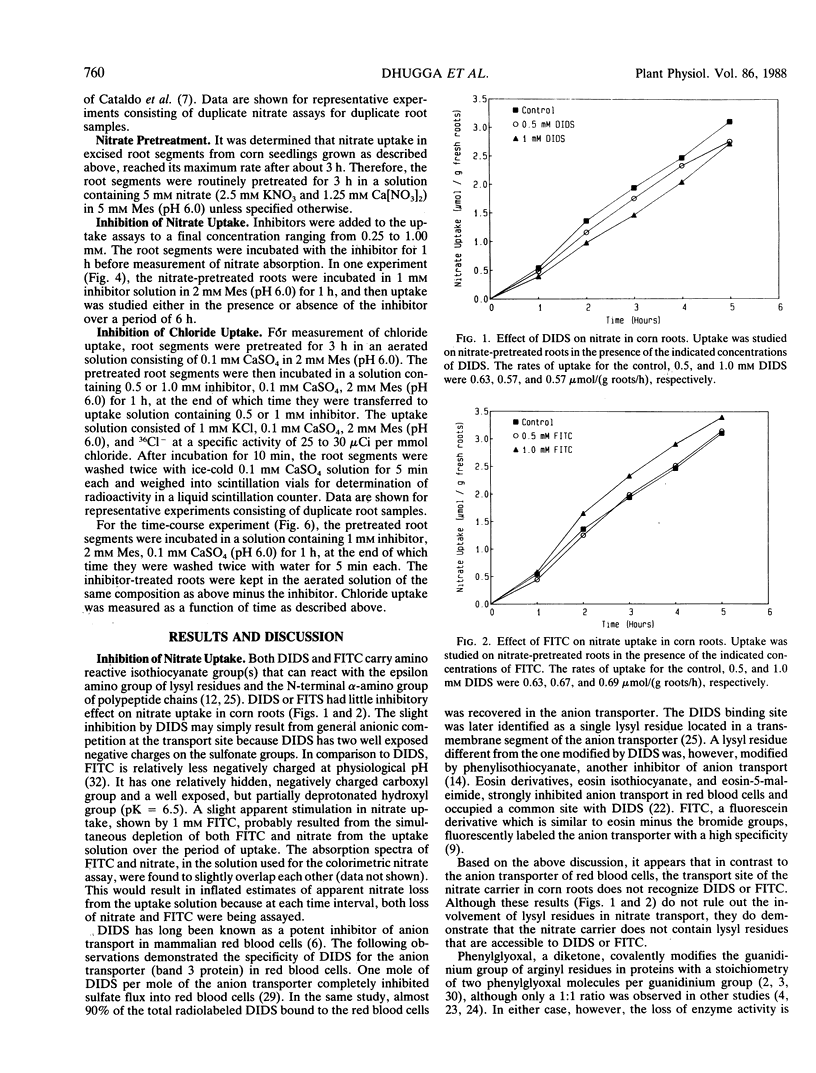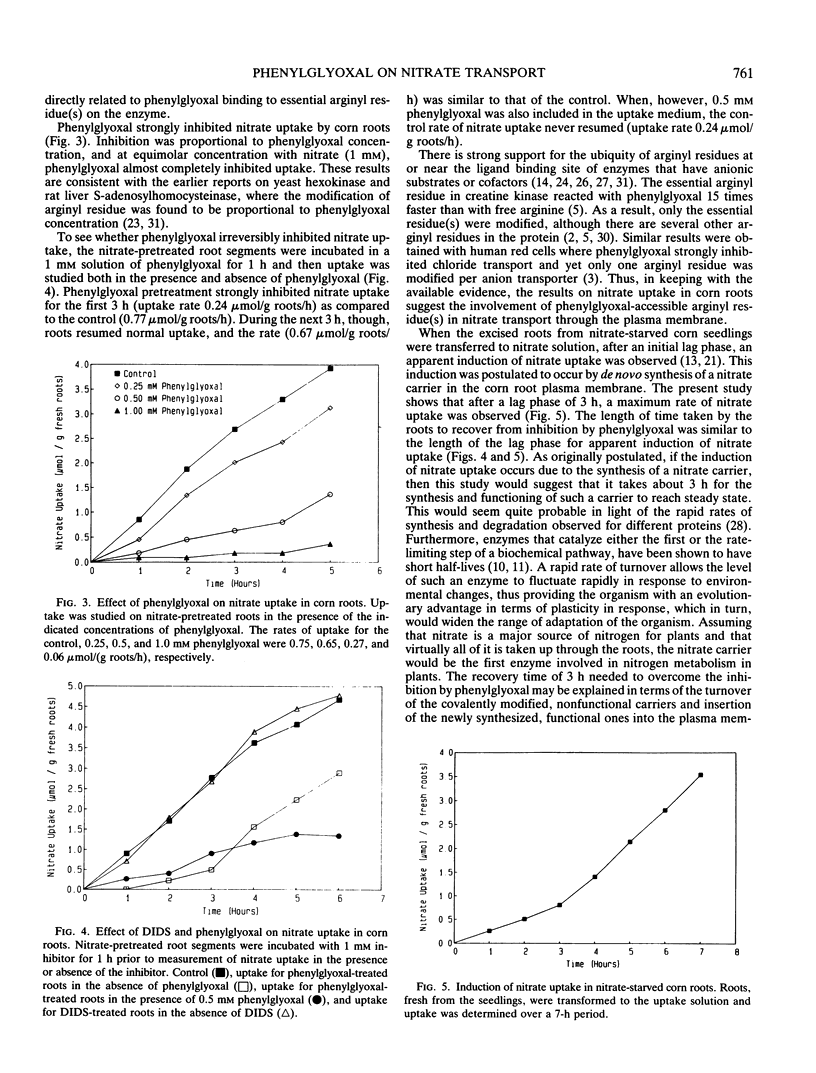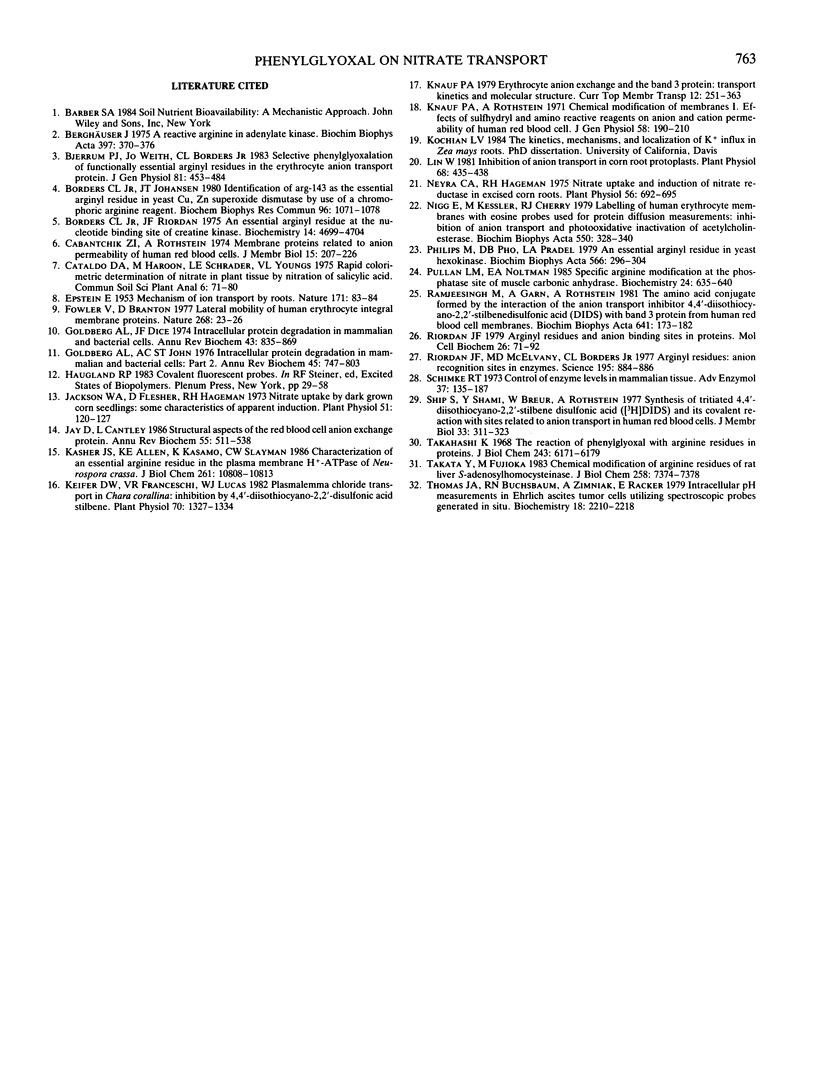Abstract
Nitrate transport in excised corn (Zea mays L.) roots was inhibited by phenylglyoxal, but not by 4,4′-diisothiocyano-2,2′-stilbene disulfonic acid (DIDS) or fluorescein isothiocyanate (FITC). Inhibition of nitrate uptake by a 1-hour treatment with 1 millimolar phenylglyoxal was reversed after 3 hours, which was similar to the time needed for induction of nitrate uptake. If induction of nitrate uptake occurs by de novo synthesis of a nitrate carrier, then the resumption of nitrate uptake in the inhibitor-treated roots may occur because of turnover of phenylglyoxal-inactivated nitrate carrier proteins. All three chemicals inhibited chloride uptake to varying degrees, with FITC being the strongest inhibitor. While inhibition due to DIDS was reversible within 30 minutes, both FITC and phenylglyoxal showed continued inhibition of chloride uptake for up to 3 hours after removal from the uptake solution. Assuming that the anion transporter polypeptide(s) carries a positive charge density at or near the transport site, the results indicate that the nitrate carrier does not carry any lysyl residues that are accessible to DIDS or FITC, whereas the chloride carrier does. Both chloride and nitrate carriers, however, seem to possess arginyl residues that are accessible to phenylglyoxal.
Full text
PDF




Selected References
These references are in PubMed. This may not be the complete list of references from this article.
- Berghäuser J. A reactive arginine in adenylate kinase. Biochim Biophys Acta. 1975 Aug 26;397(2):370–376. doi: 10.1016/0005-2744(75)90126-6. [DOI] [PubMed] [Google Scholar]
- Bjerrum P. J., Wieth J. O., Borders C. L., Jr Selective phenylglyoxalation of functionally essential arginyl residues in the erythrocyte anion transport protein. J Gen Physiol. 1983 Apr;81(4):453–484. doi: 10.1085/jgp.81.4.453. [DOI] [PMC free article] [PubMed] [Google Scholar]
- Borders C. L., Jr, Johansen J. T. Identification of Arg-143 as the essential arginyl residue in yeast Cu,Zn superoxide dismutase by use of a chromophoric arginine reagent. Biochem Biophys Res Commun. 1980 Oct 16;96(3):1071–1078. doi: 10.1016/0006-291x(80)90061-3. [DOI] [PubMed] [Google Scholar]
- Borders C. L., Jr, Riordan J. F. An essential arginyl residue at the nucleotide binding site of creatine kinase. Biochemistry. 1975 Oct 21;14(21):4699–4704. doi: 10.1021/bi00692a021. [DOI] [PubMed] [Google Scholar]
- Cabantchik Z. I., Rothstein A. Membrane proteins related to anion permeability of human red blood cells. I. Localization of disulfonic stilbene binding sites in proteins involved in permeation. J Membr Biol. 1974;15(3):207–226. doi: 10.1007/BF01870088. [DOI] [PubMed] [Google Scholar]
- EPSTEIN E. Mechanism of ion absorption by roots. Nature. 1953 Jan 10;171(4341):83–84. doi: 10.1038/171083a0. [DOI] [PubMed] [Google Scholar]
- Fowler V., Branton D. Lateral mobility of human erythrocyte integral membrane proteins. Nature. 1977 Jul 7;268(5615):23–26. doi: 10.1038/268023a0. [DOI] [PubMed] [Google Scholar]
- Goldberg A. L., Dice J. F. Intracellular protein degradation in mammalian and bacterial cells. Annu Rev Biochem. 1974;43(0):835–869. doi: 10.1146/annurev.bi.43.070174.004155. [DOI] [PubMed] [Google Scholar]
- Goldberg A. L., St John A. C. Intracellular protein degradation in mammalian and bacterial cells: Part 2. Annu Rev Biochem. 1976;45:747–803. doi: 10.1146/annurev.bi.45.070176.003531. [DOI] [PubMed] [Google Scholar]
- Jackson W. A., Flesher D., Hageman R. H. Nitrate Uptake by Dark-grown Corn Seedlings: Some Characteristics of Apparent Induction. Plant Physiol. 1973 Jan;51(1):120–127. doi: 10.1104/pp.51.1.120. [DOI] [PMC free article] [PubMed] [Google Scholar]
- Jay D., Cantley L. Structural aspects of the red cell anion exchange protein. Annu Rev Biochem. 1986;55:511–538. doi: 10.1146/annurev.bi.55.070186.002455. [DOI] [PubMed] [Google Scholar]
- Kasher J. S., Allen K. E., Kasamo K., Slayman C. W. Characterization of an essential arginine residue in the plasma membrane H+-ATPase of Neurospora crassa. J Biol Chem. 1986 Aug 15;261(23):10808–10813. [PubMed] [Google Scholar]
- Keifer D. W., Franceschi V. R., Lucas W. J. Plasmalemma Chloride Transport in Chara corallina: Inhibition by 4,4'-Diisothiocyano-2,2'-Disulfonic Acid Stilbene. Plant Physiol. 1982 Nov;70(5):1327–1334. doi: 10.1104/pp.70.5.1327. [DOI] [PMC free article] [PubMed] [Google Scholar]
- Knauf P. A., Rothstein A. Chemical modification of membranes. I. Effects of sulfhydryl and amino reactive reagents on anion and cation permeability of the human red blood cell. J Gen Physiol. 1971 Aug;58(2):190–210. doi: 10.1085/jgp.58.2.190. [DOI] [PMC free article] [PubMed] [Google Scholar]
- Lin W. Inhibition of anion transport in corn root protoplasts. Plant Physiol. 1981 Aug;68(2):435–438. doi: 10.1104/pp.68.2.435. [DOI] [PMC free article] [PubMed] [Google Scholar]
- Neyra C. A., Hageman R. H. Nitrate uptake and induction of nitrate reductase in excised corn roots. Plant Physiol. 1975 Nov;56(5):692–695. doi: 10.1104/pp.56.5.692. [DOI] [PMC free article] [PubMed] [Google Scholar]
- Nigg E., Kessler M., Cherry R. J. Labeling of human erythrocyte membranes with eosin probes used for protein diffusion measurements: inhibition of anion transport and photo-oxidative inactivation of acetylcholinesterase. Biochim Biophys Acta. 1979 Jan 19;550(2):328–340. doi: 10.1016/0005-2736(79)90219-0. [DOI] [PubMed] [Google Scholar]
- Philips M., Pho D. B., Pradel L. A. An essential arginyl residue in yeast hexokinase. Biochim Biophys Acta. 1979 Feb 9;566(2):296–304. doi: 10.1016/0005-2744(79)90033-0. [DOI] [PubMed] [Google Scholar]
- Pullan L. M., Noltmann E. A. Specific arginine modification at the phosphatase site of muscle carbonic anhydrase. Biochemistry. 1985 Jan 29;24(3):635–640. doi: 10.1021/bi00324a015. [DOI] [PubMed] [Google Scholar]
- Ramjeesingh M., Gaarn A., Rothstein A. The amino acid conjugate formed by the interaction of the anion transport inhibitor 4,4'-diisothiocyano-2,2'-stilbenedisulfonic acid (DIDS) with band 3 protein from human red blood cell membranes. Biochim Biophys Acta. 1981 Feb 20;641(1):173–182. doi: 10.1016/0005-2736(81)90581-2. [DOI] [PubMed] [Google Scholar]
- Riordan J. F. Arginyl residues and anion binding sites in proteins. Mol Cell Biochem. 1979 Jul 31;26(2):71–92. doi: 10.1007/BF00232886. [DOI] [PubMed] [Google Scholar]
- Riordan J. F., McElvany K. D., Borders C. L., Jr Arginyl residues: anion recognition sites in enzymes. Science. 1977 Mar 4;195(4281):884–886. doi: 10.1126/science.190679. [DOI] [PubMed] [Google Scholar]
- Schimke R. T. Control of enzyme levels in mammalian tissues. Adv Enzymol Relat Areas Mol Biol. 1973;37:135–187. doi: 10.1002/9780470122822.ch3. [DOI] [PubMed] [Google Scholar]
- Ship S., Shami Y., Breuer W., Rothstein A. Synthesis of tritiated 4,4'-diisothiocyano-2,2'-stilbene disulfonic acid ([3H]DIDS) and its covalent reaction with sites related to anion transport in human red blood cells. J Membr Biol. 1977 May 12;33(3-4):311–323. doi: 10.1007/BF01869522. [DOI] [PubMed] [Google Scholar]
- Takahashi K. The reaction of phenylglyoxal with arginine residues in proteins. J Biol Chem. 1968 Dec 10;243(23):6171–6179. [PubMed] [Google Scholar]
- Takata Y., Fujioka M. Chemical modification of arginine residues of rat liver S-adenosylhomocysteinase. J Biol Chem. 1983 Jun 25;258(12):7374–7378. [PubMed] [Google Scholar]
- Thomas J. A., Buchsbaum R. N., Zimniak A., Racker E. Intracellular pH measurements in Ehrlich ascites tumor cells utilizing spectroscopic probes generated in situ. Biochemistry. 1979 May 29;18(11):2210–2218. doi: 10.1021/bi00578a012. [DOI] [PubMed] [Google Scholar]


